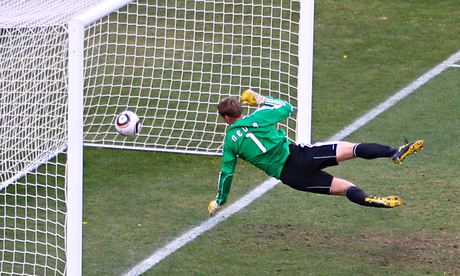Volunteer in mind-controlled exo-skeleton will kick off competition full of innovations, including goalline technology

German goalline technology is being used at the 2014 World Cup to prevent controversies such as this one, from England's match against Germany in the last tournament. Photograph: Cameron Spencer/Getty Images
In a few weeks, two key events will cap preparations for the World Cup. Both will take place at the Arena Corinthians stadium in São Paulo. One will involve the national teams of Brazil and Croatia who, on 12 June, at 5pm local time, will play each other in the opening match.
The other, even more dramatic, event is scheduled to take place a few minutes earlier. Watched by a TV audience of hundreds of millions, a volunteer who has suffered paralysis is to give the first public demonstration of a mind-controlled exo-skeleton that will allow him or her to walk.
According to the project's leader, Miguel Nicolelis, a Brazilian neuroscientist based at Duke University in North Carolina, the special suit will allow the volunteer – who has yet to be selected – to cross the football pitch using their thoughts to guide the machine's movements. Then he or she will kick the football in the centre circle to mark the official opening of the 2014 World Cup.
"The kick will inaugurate a new era of neuroscience," said Nicolelis, whose project, known simply as Walk Again, has been backed heavily by the Brazilian government. For good measure, it will also inaugurate a World Cup that is going to be dominated by technology.
Apart from the symbolic kick-off that Nicolelis and his team is planning, other hi-tech devices on display will include aerodynamically designed footballs, sensors that will determine when balls cross goallines, and systems that will automatically track players and analyse their performances throughout matches.
"This is going to be the most technologically sophisticated World Cup tournament ever staged," said data scientist Omar Chaudhuri of Prozone, the UK software company that specialises in analysing players' performances during English Premier League games. "Yes, football skills will play a key role in the tournament, but equally any country that fails to use the technologies now on offer to boost their teams' performances is likely to find itself caught out badly."
One technique developed by Prozone involves using cameras positioned around UK football grounds to track players throughout a match. Most players spend, on average, less than three minutes on the ball. Where and how they play for the other 87 minutes of a match is nevertheless crucial to the outcome of a game. Are they positioned properly at corners? Are they marking their opponents adequately?
"We hope to erect mobile cameras [at the World Cup] to replicate the system we have in the UK. This would provide managers with critically important data," said Chaudhuri.
Then there is the football itself. The last World Cup's smooth, swerving Jabulani ball was widely criticised because of its erratic, unpredictable flight path. Brazil's goalkeeper, Júlio César, compared it to a "supermarket" ball, while Italy's Gianluigi Buffon described it as "absolutely inadequate".
The new ball, the Brazuca, has been designed to avoid these criticisms. According to its maker, Adidas, this has been achieved by giving it a rough surface in the form of long, deep seams. These agitate the air flowing over the ball but reduce the size of "wake" behind it. By contrast, the Jabulani had a smooth surface which created a mixture of turbulent and smooth airflow that left an asymmetric wake behind the ball. By designing the Brazuca to guarantee that the air it encounters is agitated quickly and efficiently, the ball avoids in-flight unpredictably, it is claimed.
Equally controversial at the last World Cup was the decision not to allow a goal after a shot by Frank Lampard clearly crossed the German goalline when England were losing 2-1. Although England eventually lost 4-1, many argue that if Lampard's equaliser had been allowed, the result would have been very different.
As a result, Fifa came under intense pressure to introduce goalline technology for the 2014 World Cup and last year announced that it had decided to allow the German firm GoalControl to provide a camera system that would reveal, definitively, when balls cross goallines. "The unique features of our system are the outstanding flexibility and accuracy," said Dirk Broichhausen, managing director of GoalControl.
However, it will be the tournament's kick-off by a patient wearing an exo-skeleton that will be the real eye-opener, though Nicolelis has indicated that his team is under intense pressure to get the exo-skeleton ready. He remains positive, however. "In Brazil, people are now talking about neuroscience when they talk about the World Cup," he said. "That is already enough of an accomplishment."
No comments:
Post a Comment